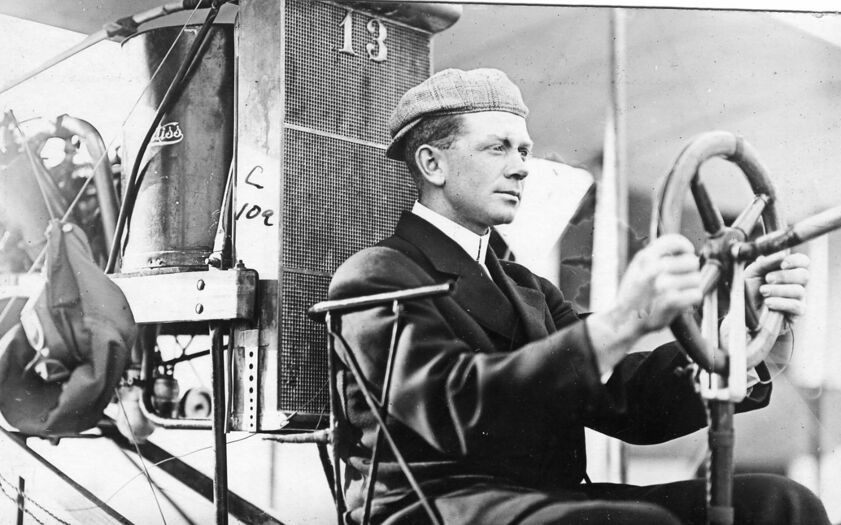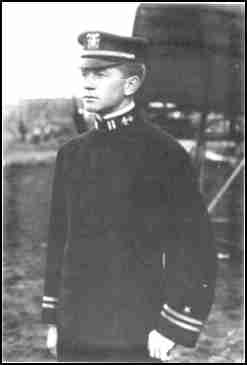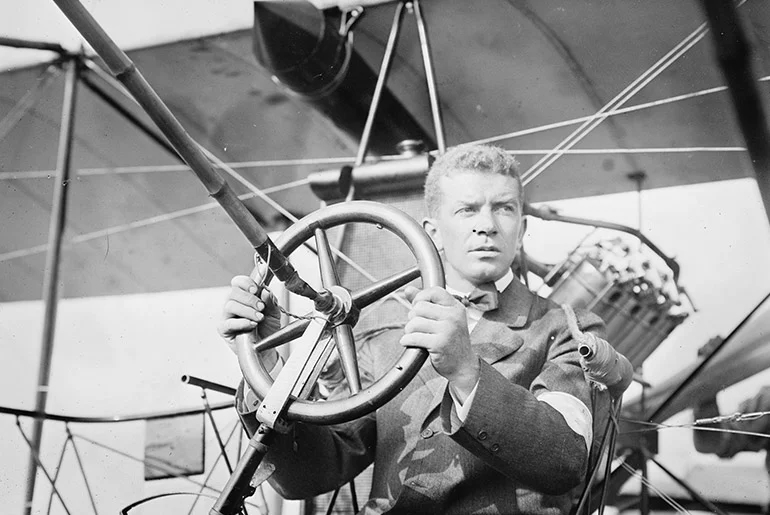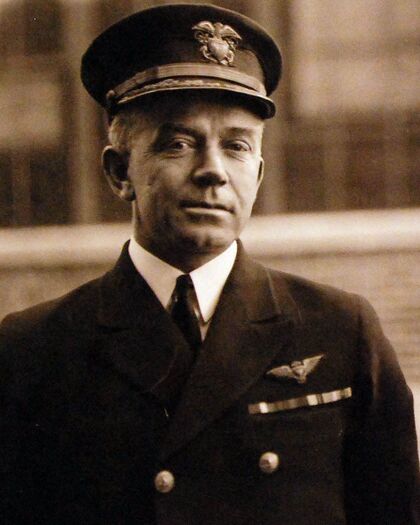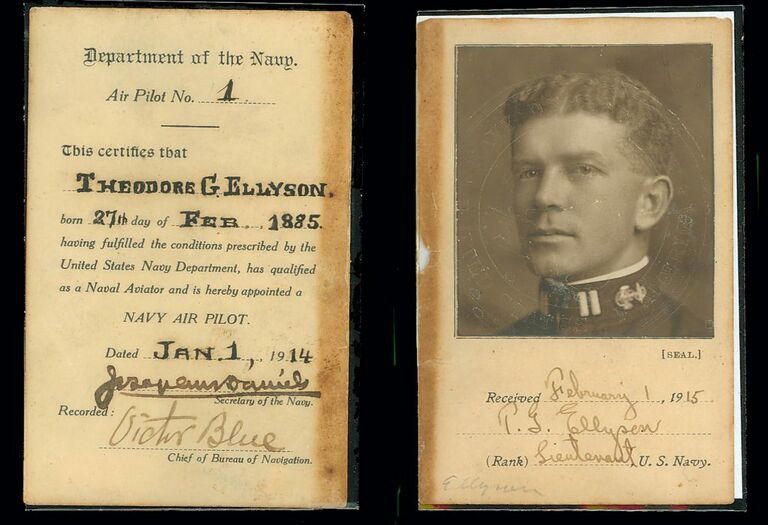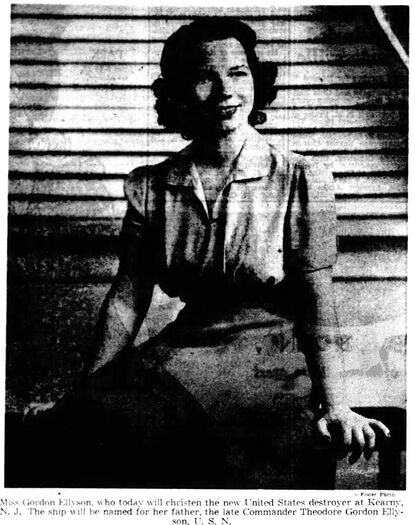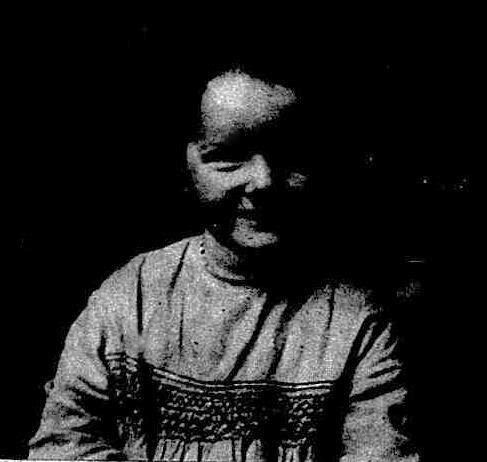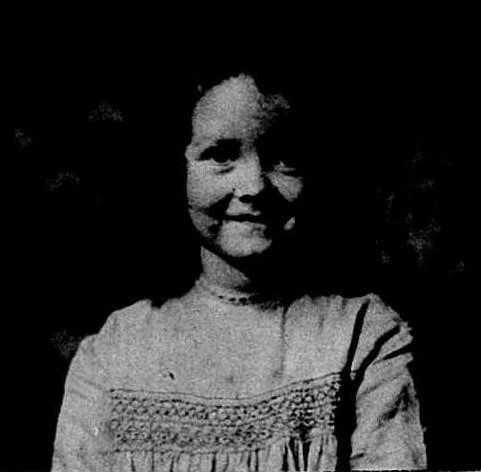THEODORE G. ELLYSON, CDR, USN
Theodore Ellyson '05
Lucky Bag
From the 1905 Lucky Bag:
Theodore Gordon Ellyson
Richmond, Virginia
"Spuds" "Ella" "Reddy."
A hopeless but not hopless fusser. Fond of night raids and prefers sitting in the corridor with a sack of "Bull" to turning in. His curly hair and fetching pronunciation of the word "house" are too much for the fair sex. Posed as a savoir Plebe year and then rested on his laurels. Will stop at nothing in search of a good time; knows all the easy places on the wall, and prefers "Star Plug" to all others. "Buffalo Bill" second class leave.
Buzzard (1) Class Baseball (3) Baseball Scrubs (2) Santee (3, 2) Chesapeake (4) Class Football (1).
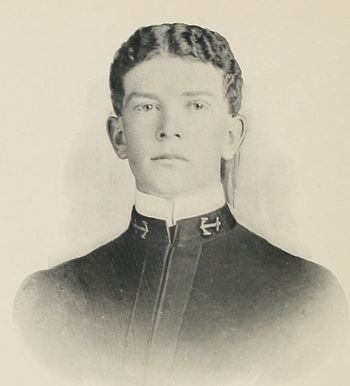
Theodore Gordon Ellyson
Richmond, Virginia
"Spuds" "Ella" "Reddy."
A hopeless but not hopless fusser. Fond of night raids and prefers sitting in the corridor with a sack of "Bull" to turning in. His curly hair and fetching pronunciation of the word "house" are too much for the fair sex. Posed as a savoir Plebe year and then rested on his laurels. Will stop at nothing in search of a good time; knows all the easy places on the wall, and prefers "Star Plug" to all others. "Buffalo Bill" second class leave.
Buzzard (1) Class Baseball (3) Baseball Scrubs (2) Santee (3, 2) Chesapeake (4) Class Football (1).
Loss
Theodore was lost on February 27, 1928, when the plane he was aboard crashed en route to Annapolis, where his "small daughter lay ill." He survived the crash and had removed his shoes in the water but was unable to remove his heavy flying suit before he sank. It was his 43rd birthday.
He was the executive officer of USS Lexington (CV 2) and Naval Aviator #1.
Other Information
From Naval History and Heritage Command:
Theodore Gordon Ellyson, the first Naval officer to qualify as an airplane pilot, and distinguished pioneer of US Naval Aviation, was born on February 27, 1885, in Richmond, Virginia.
Appointed Naval Cadet, he entered the US Naval Academy, Annapolis, Maryland, from the Third District of Virginia in June 1901, and was graduated with the Class of 1905, on January 30, 1905. After the two years at sea, then requited by law before commissioning, he was commissioned Ensign in the US Navy on January 31, 1907, and subsequently advanced as follows: Lieutenant, junior grade, on January 31, 1910; Lieutenant, September 16, 1910; Lieutenant Commander, May 23, 1917; and Commander on July 1, 1918.
During the five years following his graduation from the Naval Academy in 1905, he served consecutively at sea in USS Texas at Guantanamo, Cuba; USS Missouri; as Watch and Division Officer of USS Pennsylvania, and later USS Colorado; and in USS West Virginia, USS Rainbow and USS Shark on Asiatic Station. After his return to the United States in April 1910, he commanded USS Tarantula until November of that year, then had duty in connection with fitting out the USS SEAL at the Newport News Shipbuilding and Dry Dock Company, Newport News, Virginia. He commanded her briefly after her commissioning on December 2, 1910.
Ordered on December 23, 1910, to Lon Angeles, California, for instruction in aviation under Mrs. Glenn Curtiss, pioneer aviator who had offered to train a pilot for the Navy free of charge, he reported there on January 2, 1911. While a student under Mr. Curtiss, he cooperated with his instructor in the design of pontoon for airplanes and became the first passenger ever to go aloft in a hydroaeroplane when he made a flight in February 1911, with Mr. Curtiss at the controls.
On February 17, 1911, young Ellyson (then a Lieutenant) observed the use to which airplanes might be employed aboard ships. On that day Mr. Curtiss flew the hydroplanes from North Island alongside the USS Pennsylvania at anchor in San Diego Bay, and, with Ellyson directing operations from a rowboat, the plane was hoisted aboard the ship. later it was lowered to the water and returned to North Island. Commander Ellyson, in cooperation with Mr. Curtiss then began work on a device from which a plane might be launched from a vessel.
On September 7, 1911, with Commander Ellyson piloting, a plane equipped with a slotted pontoon was successfully launched from wire cable attached to a dock at Hammondsport, New York. The wire cable apparatus was abandoned in favor of a catapult launching device being developed at the Naval Gun Factory, Washington, DC. In July 1912, flying a Curtiss A-1 Commander Ellyson attempted the first catapult shot, at AnnapolisMaryland. Is ended unsuccessfully, however, and the catapult was redesigned and mounted on a barge at the Washington, DC, Navy Yard. On November 12, 1912, he made a successful take-off from the device.
From the time Ellyson began instruction in aviation in January 1911, until April 29, 1913, he devoted all of his time to active flying and experimental work in aviation. This included the establishment of Naval Aviation Camps at Annapolis in September 1911 and at North Island, San Diego, in January 1912, and several endurance, altitudes and speed records. He made the first long distance flight ever attempted by Naval airmen, on November 3, 1911 when, with Admiral (then Lieutenant) John H. Towers, he flew a plane from Annapolis, Maryland, to Milford Haven, Virginia. The 112-mile flight required 2 hours, 2 minutes, which was a non-stop distance record for hydroaeroplanes at that time.
In 1917 he had duty at the Naval Academy and with the Midshipmen on cruise in USS Wyoming and USS Kansas. On February 14, 1918, he was detached for duty at the Submarine Chaser Base, New London, Connecticut, and in June arrived in London, England, for duty with a Submarine Chaser Squadton at US Naval Base #27, at Plymouth, England. For his war service he was awarded the Navy Cross and cited: “For distinguished service in the line of his profession as Assistant for Operations to the Commander, Submarine Chaser Detachment ONE. He was largely responsible for the development of successful submarine-chaser tactics and doctrine.”
Following the Armistice in November 1918, he remained in the European area, commanding Nucleus Crew #14 (zeppelin) from March to May 1919. Upon his arrival in the United States, he assisted in fitting out USS J. Fred Talbot at the William Cramp and Sons Co., Philadelphia, and served on board that destroyer from her commissioning, June 30, 1919, until July 1920. During the next five months he successively commanded USS Little and USS Brooks.
On January 10, 1921, he was ordered to Hampton Roads, Virginia, to serve for eight months as Executive Officer of the Naval Air Station, Naval Operating Base. The Bureau of Aeronautics was established in the Navy Department on September 1, 1921, and on October 21 Commander Ellyson became Head of the Plans Division of that Bureau. He remained in that assignment until December 1922, when he became the Aviation Member of the US Naval Mission to Brazil, cooperating in the reorganization of the Brazilian Navy. He returned to the Bureau of Aeronautics in May 1925.
On July 20, 1925, he assumed command of Torpedo Squadron ONE, and from March to June 1926 was Executive Officer of USS Wright, seaplane tender. On June 23, 1926, he was ordered to duty in connection withfitting out the USS Lexington, the Navy’s second aircraft carrier and was on board when she was placed in commission. The Lexington and her sister ship, USS Saratoga, were originally designed for battle cruisers, but during their construction were changed to aircraft carriers as a result of the Limitation of Armament Treaty.
Commander Ellyson was killed on February 27, 1928, his forty-third birthday, in a crash of an airplane in lower Chesapeake Bay, while on a night flight from Norfolk, Virginia, to Annapolis, Maryland.
In addition to the Navy Cross, Commander Ellyson had the Victory Medal, Submarine Chaser Clasp. On February 27, 1941, fifty-six years from the date of his birth and thirteen years after his death, announcement was made of the naming of a new auxiliary airfield at the Naval Air Station, Pensacola, Florida, ELLYSON FIELD, in honor of the late Commander Theodore G. Ellyson, USN.
The USS Ellyson (DD-454), built just prior to World War II, was also named to honor Commander Ellyson. Built under authorization of Act of Congress of May 17, 1938, by the Federal Shipbuilding and Dry Dock Company, Kearny, New Jersey, USS Ellyson was constructed with a peace- time precision which made her one of the fastest destroyers ever to hit the waterways for any navy. When launched on July 5, 1941, she was christened by Miss Gordon Ellyson, daughter of Commander Ellyson. Commissioned on November 28, 1941, USS Ellyson had a distinguished World War II record, first in the Atlantic, later the Pacific, serving as the flagship of Fleet Units from June 15, 1942, throughout the remainder of the war.
He was buried in the Naval Academy Cemetery, in Annapolis.
From researcher Kathy Franz:
On May 26, 1900, Theodore joined his friends on an outing to Old Point. They took a steamer Old Point Comfort around Hampton Roads for several hours and had lunch aboard.
Theodore was educated at McGuire's University School.
In August 1906, he was on the Pennsylvania.
In 1910, he was trained by the Wright brothers. He was the first naval air pilot, license “Number 1.”
In March 1911, Theodore sat on the pontoon rigged below Mr. Glenn Curtiss' aviator's seat. He could see bottom at a depth of 25 feet, and afterward he said that in clear water it would be possible to see submarines and drop bombs with precision.
On July 1, 1911, on Lake Keuka, Theodore flew the newly developed hydro-aeroplane. She was much larger than the standard Curtiss machine and equipped with a 70 horsepower motor. Theodore flew four times around two boats anchored in the lake 1,600 feet apart.
On November 15, 1912, he married Helen Mildred Lewis Glenn in Washington, D.C.
In 1916, he was ordered to Vera Cruz. During World War I, he was commander of a destroyer in European waters, and his ship was the first to enter the Kiel Canal after the war.
His wife and two daughters, Helen, age 5, and Mildred, age 3 applied for passport in April 1920 to join Theodore in Italy. In December 1920, they sailed back to New York City from Calais, France.
In May 1922, Theodore and Lt. V. C. Griffin ('12) flew a Vought plane to a pageant held in Richmond. Governor Trinkle refused a ride since he had suffered two accidents recently. In the opening parade, his horse ran away, and later his automobile collided with a live electric wire at night. His wife felt the airplane ride would be tempting Providence.
In June 1925, Theodore's family sailed from Rio de Janiero to New York City.
Theodore was the first man to be catapulted in a plane from the deck of a ship and the first to be shot upward from a submarine through a torpedo tube.
Ten years after his death In 1938, Ellyson Avenue at the naval air station in Pensacola was named for him.
Theodore's widow married Alfred Gray of Richmond in March 1930. Their three daughters were: Helen, Mildred, and Elizabeth. Helen married Worden Churchill Tyler in October 1936 and Daniel Webster Abercrombie, III, in 1947. Mildred, who was the sick child Theodore was on his way to see, married Perry Kenneth Schulz in December 1936, and in April 1942, at the St. Andrews Chapel of the Naval Academy, she married John Martine Court ('36). Elizabeth married Comdr. John Harllee Carmichael ('36) on October 24, 1944. She was given in marriage by her father's classmate Capt. Alva B. Court ('05).
Theodore's father Henry was a newspaper publisher and a director of the National Bank of Virginia. His mother Elizabeth was a member of the United Daughters of the Confederacy and was treasurer of the Confederal Memorial Library Society. His sisters were May (Mrs. A. Ruggles Nelson) and Mrs. Jesse R. Taylor. His brothers were Donald P., H. K., and Douglas Walker, a mechanical engineer.
Photographs
From Hall of Valor:
The President of the United States of America takes pleasure in presenting the Navy Cross to Commander Theodore Gordon Ellyson, United States Navy, for distinguished service in the line of his profession as Assistant for Operations to Commander, Submarine Chaser Detachment 1, during World War I. Commander Ellyson was largely responsible for the development of successful subchaser tactics and doctrine.
Service: Navy
Division: Submarine Chaser Detachment 1
The "Register of Commissioned and Warrant Officers of the United States Navy and Marine Corps" was published annually from 1815 through at least the 1970s; it provided rank, command or station, and occasionally billet until the beginning of World War II when command/station was no longer included. Scanned copies were reviewed and data entered from the mid-1840s through 1922, when more-frequent Navy Directories were available.
The Navy Directory was a publication that provided information on the command, billet, and rank of every active and retired naval officer. Single editions have been found online from January 1915 and March 1918, and then from three to six editions per year from 1923 through 1940; the final edition is from April 1941.
The entries in both series of documents are sometimes cryptic and confusing. They are often inconsistent, even within an edition, with the name of commands; this is especially true for aviation squadrons in the 1920s and early 1930s.
Alumni listed at the same command may or may not have had significant interactions; they could have shared a stateroom or workspace, stood many hours of watch together, or, especially at the larger commands, they might not have known each other at all. The information provides the opportunity to draw connections that are otherwise invisible, though, and gives a fuller view of the professional experiences of these alumni in Memorial Hall.
July 1906
July 1907
January 1908
January 1909
January 1910
January 1911
January 1912
January 1913
January 1915
January 1916
January 1917
March 1918
January 1919
January 1920
January 1921
January 1922
May 1923
July 1923
September 1923
November 1923
January 1924
March 1924
May 1924
July 1924
September 1924
November 1924
January 1925
March 1925
May 1925
July 1925
October 1925
January 1926
October 1926
January 1927
April 1927
October 1927
January 1928
Related Articles
Rogers Ransehousen '21 and Hugo Schmidt '16 were also lost in this crash.
Namesakes
USS Ellyson (DD 454) was named for Theodore; the ship was sponsored by his daughter.
Ellyson Park at the Naval Academy is named for him.
Memorial Award
The Commander Theodore Ellyson Aviator Production Excellence Award is awarded each year to the most deserving fleet replacement squadron in the Navy and Marine Corps.
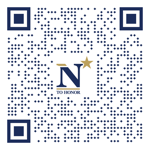
The "category" links below lead to lists of related Honorees; use them to explore further the service and sacrifice of alumni in Memorial Hall.
